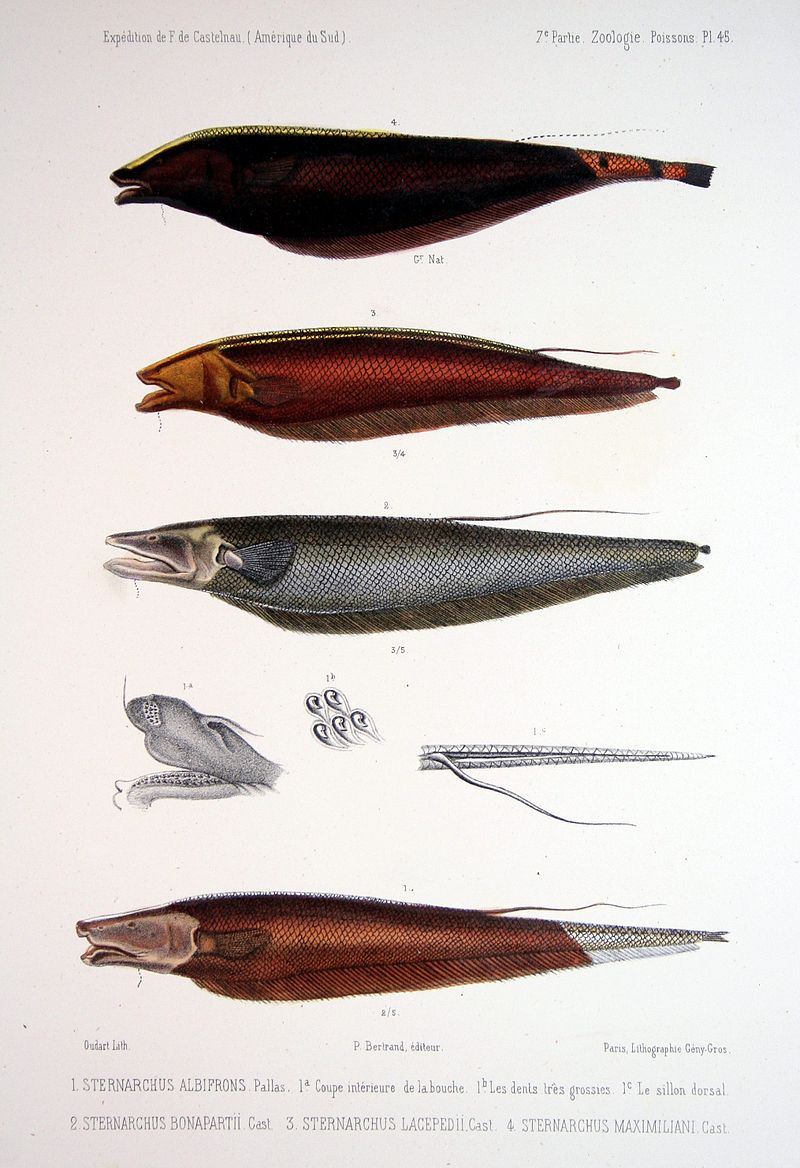
Gabi Serrato Marks
How does an electric fish get its charge?
An accidental genome duplication (or two) created the highest frequency electrical discharge known in animals.
Electric fish are strange creatures. These real-life Pikachus—the cute Pokemon character that can store electricity—actually have specialized organs that can create large electric fields. Different species produce different amounts of electricity: strongly electric fish, like the infamous electric eel, use their powerful discharges to stun prey or defend themselves from predators, while weakly electric fish, like the ghost knifefish of the Apteronotidae family, use gentler discharges to sense their environment or communicate in murky or dark water.

The perfect time for an electric organ discharge.
Photo by Cristian Palmer
In most cases, the fantastical organs that help these fish survive evolved from muscles. Most electric fish create their signals by co-opting normal processes involved in muscle movement, like the electric discharges from sodium channels. Sodium channels are tiny, tightly-controlled pores that control how positively charged sodium ions enter cells, creating a current. As they evolved, electric fish lost a sodium channel in their muscles, moving it to their electric organ, allowing them to discharge electricity and send out signals without causing their muscles to twitch. This crucial change is one of many remnants of a genetic hiccup early in fish evolutionary history that duplicated every gene. That is to say that at some point, ancient fish made a second copy of every gene in their genome. This gave fish extra DNA to play around with and alter, like having a spare car in your driveway to tinker with.
But genetics alone doesn’t explain the diversity of electrical signaling languages in electric fish. Some fish send out brief pulses of electricity, with long pauses between them, similar to sonar on navy ships. Others discharge huge, lethal voltages when threatened. Ghost knifefishes (Apteronotidae) are particularly curious, generating an incredibly fast, continuous electric discharge. But their supercharged system isn’t the only unusual thing about these fish—their electric organ evolved from their spinal cord instead of their muscle, and can generate signals spontaneously without any input from the brain.
Intrigued by this oddity among oddities, a group of American researchers combined gene sequencing, evolutionary analysis, and biophysical experiments to find the genes responsible. Wondering how knifefish may have modified their sodium channels, the researchers found that, in addition to the genome duplication event common to all electric fish, Apteronotidae also duplicated a second sodium channel gene (scn4ab). The researchers estimated that the newly duplicated gene started to express in the spinal cord within two million years, a breakneck pace in evolutionary terms. An extra gene coming from this second duplication, scn4ab1, now makes 20 to 45 percent of all sodium channels in the knifefish's electric organ. This is the first example of a muscle sodium channel gene appearing in a non-muscle tissue.
But it wasn't the only thing that made Apteronotidae unique. The order of amino acid “building blocks” that make up the sodium channel protein also changed. Such amino acid modifications can have dramatic effects on a protein's function. For example, small changes in amino acid sequences are responsible for both cystic fibrosis and sickle cell anemia in humans.

Apteronotidae actually had many more mutations than expected by random chance. A finding like this is really exciting for evolutionary biologists. Natural selection generally purges harmful mutations from the gene pool, allowing only harmless or beneficial mutations to reproduce in the next generation. To find out whether the changes in the sodium channel's amino acid sequence changed how the protein functioned, the team took a human sodium channel, modified it, and expressed it in frog cells (which are easy to mess around with in the lab). Using this model channel, they were able to run a number of electrophysiological tests, exploring how the changes affected the electric currents of a cell. They found the Apteronotidae substitutions essentially acted like a doorstop, making the channel leakier than normal—exactly what you need to create the continuous electric current characteristic of this group of fish.
Genome duplication events are rare, but extremely powerful, assistants to evolution. Having extra copies of key genes can create a “safety net” that allows otherwise strange, useless, or even harmful modifications to persist. Apteronotidae has apparently benefited from two such duplications. The first, shared with all electric fish, gave rise to their unique electric abilities. Later on, a second genome duplication led to its extreme electrical talent. It's just the latest example of evolution's winding, unpredictable path—and the marvels that can develop along the way.
